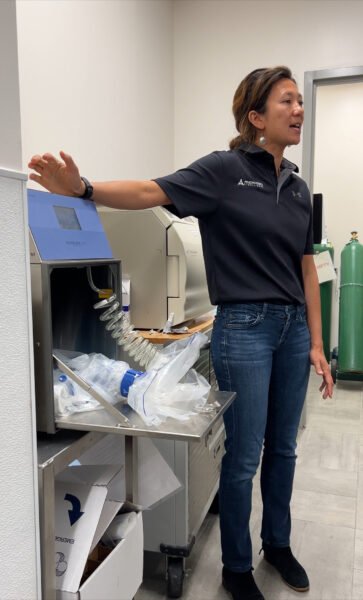By Karen E. Butler, Director of Communications

on-site FREE Key Operator training for staff at Veterinary Emergency Group (VEG) in NYC in April. Andersen provides training for the life of a sterilizer.
Andersen Sterilizers was founded by H.W. Andersen, M.D., 66 years ago. As a young surgeon at Bellevue Hospital, Dr. Andersen developed a line of nasogastric tubes and wound drains that dramatically improved upon the then-current designs. The need to effectively sterilize these delicate instruments led to the launch of Andersen Sterilizers and its state-of-the-art systems which offer terminal sterility, an ultra-gentle cycle, and unparalleled compatibility. Since its launch, veterinary practices worldwide have chosen Andersen’s tabletop EO sterilizers to reprocess their most costly and delicate instruments.
Effective Yet Gentle Cycles
Andersen’s systems do not deteriorate expensive medical instruments the way other sterilization modalities can. FDA-cleared, Andersen sterilizers effectively preserve instruments but most importantly, they protect patients. Studies show that the instances of antimicrobial-resistant bacteria in pets are on the rise. In fact, the European Society of Clinical Microbiology and Infectious Diseases Global Congress in Barcelona recently identified and documented cases of “superbugs” being passed between pets and their healthy owners in Europe.
“Our systems offer terminal sterility and use 90 percent less EO than any other system on the market,” said Steve Brown, corporate account manager. “These systems effectively sterilize a wide range of delicate instruments, sharps, plastic, cellulose, rubber and other items that would degrade in an autoclave. They are ideal for sterilizing electro-cautery handpieces, cautery units, light handles, and also drapes and gowns.”
Exclusive Technology
Andersen’s exclusive and proprietary EO-Flexible Chamber Technology (EO-FCT) sterilization process is a unique method of gas sterilization. Compared to traditional
“Our systems offer terminal sterility and use 90 percent less EO than any other system on the market.”
Steve Brown, Corporate Account Manager
ethylene oxide chambers, EO-FCT systems are considered by the FDA to be a non-traditional or “Category B” method of sterilization.
In addition to their remarkable gas efficiency (using just 17.6 grams of EO per cycle), Andersen EO-FCT systems sterilize at room temperatures without deep vacuum or steam (no external vacuum lines or steam generator) — making cycles both incredibly compatible and gentle.
“This Flexible Chamber Technology is Andersen’s secret sauce,” said Brown. “It’s exclusive, patented and exhaustively tested. We have several FDA Clearances. No other system on the market has undergone this rigorous testing. Our technology is precise, reliable and proven.”
Active Aeration in the Same Chamber
After a cycle, a purge probe flushes the sterilization bag with a constant flow of fresh air in as short a time as two hours. Operators do not need to transfer items to a separate area for aeration. Active aeration can continue indefinitely within the sterilizer until products are removed.
Affordable
Andersen’s Anprolene systems are affordable and easy and inexpensive to install. Many practices experience a full return on investment in a period of just a few months — if not a few weeks.
“Cost savings is a big deal for a practice’s bottom line,” shared Richard Brooks, a sterile processing technician at Friendship Animal Hospital in Washington, D.C. “We use electro-cautery which can cost up to $500. With our Andersen system, we can re-sterilize our electro-cautery not only quickly, but we then can get about 15 uses out of each unit.”
Zero Emissions
When paired with an Andersen sterilization system, Andersen abators achieve virtually zero emissions. Andersen abators are simple, cartridge-based systems that employ a dry catalyst resin. The resin converts ethylene oxide to biodegradable organic compounds. The replaceable abator cartridge has a 200-cycle capacity. Spent cartridges are non-hazardous and can be discarded in the trash receptacle or returned to Andersen.
Free Training for The Life of Your System
Lastly, Andersen offers free Key Operator training for the life of its systems and free customer support seven days a week, 24 hours a day. Andersen account representatives are available to train veterinary staff throughout the life of a sterilizer.
“We build strong, lasting relationships with our customers,” said Brown, who has been affiliated with Andersen for more than seven years. “We equip practices with the knowledge and skills they need to successfully operate and maintain these state-of-the-art systems.”
For more information on Andersen’s FDA-cleared sterilization solutions or to schedule Key Operator training, please visit sterility.com/contact. For more information on ethylene oxide, check out our EO Fact Sheet.
